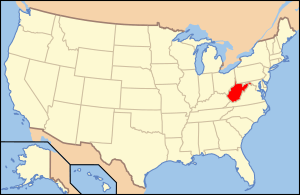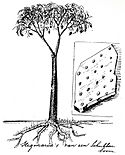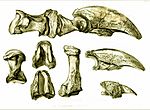Paleontology in West Virginia facts for kids

Paleontology in West Virginia is all about studying ancient life in the state of West Virginia through fossils. West Virginia has a long history of life, starting way back in the Cambrian period.
For a long time during the early Paleozoic Era, West Virginia was covered by a shallow sea. This sea was home to amazing creatures like corals, eurypterids (sea scorpions), graptolites, nautiloids, and trilobites. Later, during the Carboniferous period, the sea was replaced by huge, green coastal swamps. These swamps are why West Virginia has so many fossil plants today! Amphibians also lived in these swamps.
There's a big gap in West Virginia's fossil record from the Permian period all the way to the end of the Cenozoic Era. This means we don't find fossils from the time of the dinosaurs here. However, during the recent Ice Age, even though glaciers didn't reach West Virginia, the state was home to giant animals like mammoths, mastodons, and huge ground sloths. One famous ground sloth, Megalonyx jeffersonii, was studied by Thomas Jefferson. In 2008, this species became West Virginia's official state fossil.
Contents
Ancient Life in West Virginia
Life in Ancient Seas

About 500 million years ago, during the Cambrian period, West Virginia was mostly covered by a shallow sea. This sea was full of life, including graptolites, stromatolites, trilobites, and worms. The oldest signs of life in West Virginia come from the many fossils found in the Cambrian Antietam Formation.
West Virginia's ancient sea continued into the next period, the Ordovician. Graptolites lived here and left their remains in dark shales. At the same time, mountains began to rise in the eastern part of the state.
During the Silurian period, West Virginia had both sea and non-sea environments. Very salty seawater during a dry time left behind evaporites, which helped preserve West Virginian eurypterids. Other Silurian creatures included straight-shelled nautiloids and many ostracods (tiny crustaceans).
By the late Devonian period, the sea began to shrink and move west. Reddish rocks called the Hampshire Formation were laid down as the sea pulled back. During the change from the Silurian to the Early Devonian, West Virginia was home to corals, whose remains turned into fossils.
Swamps, Forests, and Amphibians
During the late Devonian, sediments from mountains outside the state started filling in West Virginia's seas. However, the state was covered by sea again during the early part of the Carboniferous period. By the Middle Mississippian time, the sea had spread over the state once more, depositing the Greenbrier Formation. This was the last important rock layer formed in a marine environment.
Around 310 million years ago, the Mississippian period ended, and West Virginia became dry land. During the late Mississippian, West Virginia was very swampy. The many plants that grew here left behind lots of plant fossils. Anthracosaur amphibians also lived in Mississippian West Virginia. One long-bodied amphibian, about 80 cm (31 inches) long, left behind footprints called Hylopus hamesi. This animal might have been Protergyrinus scheelei, an amphibian known from fossils found in West Virginia. Its tracks show it could both walk on land and swim.
In the Pennsylvanian period, West Virginia was low-lying. Sometimes, it even dipped below sea level. Huge river systems created large deltas. Swamps were everywhere, and these became the coal seams we see today. The thick plants in these swamps left behind many fossils. The Carboniferous coal swamps were mostly filled with ground pines like Lepidodendron, which could grow over 100 feet (30 meters) tall! Sigilaria was even bigger, with a base up to six feet (1.8 meters) wide. Other plant fossils from this time include the leaves of seed ferns like Alethopteris, Callipteridium, Callipteris, Lescuropteris, and Linopteris. Neuropteris was another fern-like plant, and the true fern Pecopteris also grew here. Amphibians also lived in these swamps.
Between 270 and 255 million years ago, during the Permian period, the Appalachian Mountains began to form. West Virginia started to lose sediments due to erosion instead of gaining them. Since the Appalachians began rising, no part of West Virginia has been covered by seawater.
No Dinosaurs, But Ice Age Giants!
There are no rocks from the Triassic, Jurassic, or Cretaceous periods in West Virginia. This means the entire Mesozoic Era (the time of the dinosaurs) is missing from the state's rock record. So, no dinosaur fossils have ever been found in West Virginia.
The next periods, the Paleogene and Neogene of the Cenozoic Era, are also missing from the state's rock record. During the Ice Age, glaciers never reached West Virginia. However, they came very close to the northern part of the state. The glaciers blocked the Monongahela River, forming a lake that stretched as far south as Weston.
Local wildlife during the Ice Age included mammoths, mastodons, and giant ground sloths. Their remains have been found in local caves. One of the most famous fossils from West Virginia is the American cheetah (Miracinonyx inexpectatus).
Discovering West Virginia's Past
In the late 1700s, workers digging for saltpeter in a cave in what was then Greenbrier County, Virginia, found some fossil limb bones. In 1796, a man named John Stuart sent these bones to Thomas Jefferson, who would later become president. Jefferson realized they belonged to a type of animal unknown to science and named the creature Megalonyx. The cave where these fossils were found was later thought to be Organ Cave.
Since the industrial revolution, coal mining has led to many discoveries of fossil footprints. These are often found by accident when miners remove the rock below the footprints, leaving them visible on the tunnel's ceiling.
More recently, in 1990, scientists Frederick A. Sundberg and his team named a new type of fossil footprint, Hylopus hamesi. These amphibian footprints came from the latest Mississippian Bluefield Formation. These footprints were the oldest evidence of land-dwelling backboned animals in the eastern United States. Based on the foot shape, researchers believed the tracks were made by anthracosaurs, possibly the species Protergyrinus scheelei, which was also known from West Virginia's Mississippian rocks. Different track patterns suggested that some were made while the animal was swimming, showing it could both walk on land and swim underwater.
In 1993, two pieces of a Megalonyx shoulder blade were found in Haynes Cave in Monroe County, West Virginia. This suggested that Haynes Cave, not Organ Cave, might be the true place where Thomas Jefferson's Megalonyx bones were found. In 1995, Fred Grady further showed that the Megalonyx fossils were likely not from Organ Cave. The original discovery site was owned by Frederic Gromer, who never owned Organ Cave but did own Haynes Cave. Other details from descriptions of Haynes Cave also support it being the true discovery site. In 2008, Megalonyx jeffersonii was officially named the West Virginia state fossil.
Where to See Fossils
- West Virginia Geological and Economic Survey Museum
- Grave Creek Mound Archaeological Complex, Moundsville West Virginia
- The Lost World Caverns Visitor Center and Natural History Museum
- Bluestone Museum
- West Virginia Natural History Museum, Morgantown
Fossil Events
- Morgantown Gem, Mineral, and Fossil Show
- Kanawha Gem, Mineral, and Fossil Show



